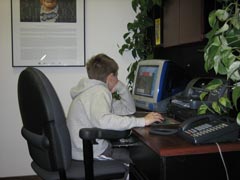
Vol. V, No. 1, January-March 2006
- How Long Does It Take to Complete an Early Education Center?
- One Size Does Not Fit All: Sizing Computers for Children
- Study Finds No Safe Level of Lead
- Lincoln Museum Receives Thea Award
- Let the Sun Shine In
- Evaluation of Full-Spectrum Fluorescent Lighting
- Valentine's Day in Morocco
- Plant a Private Space for Children
- Connecting the World's Children to Nature
- Upcoming Presentations
- Alert: Early Childhood Facilities Design Institute Is in Danger
- Current Projects
One Size Does Not Fit All: Sizing Computers for Children
 There
is very little written about ergonomics for children, yet we know that
in the workplace, ergonomics are important to protect against repetitive
injuries and neck or back strains. Injuries to the spine and soft tissue
are harder to track than traumatic injuries such as broken bones. This
may partially explain why the topic of ergonomics for children has been
overlooked. In observing how children should be using computers, we can
apply what we know about adult ergonomics:
There
is very little written about ergonomics for children, yet we know that
in the workplace, ergonomics are important to protect against repetitive
injuries and neck or back strains. Injuries to the spine and soft tissue
are harder to track than traumatic injuries such as broken bones. This
may partially explain why the topic of ergonomics for children has been
overlooked. In observing how children should be using computers, we can
apply what we know about adult ergonomics:
- Make sure you have a child-size keyboard and mouse.
- The keyboard and mouse should be directly under the fingers when elbows are bent to about 90 degrees with upper arms relaxed. Make sure the child's wrists stay straight when keying or mousing, and not bent up or down; this helps prevent carpal tunnel syndrome.
- Children should not need to bend their necks back to look at the screen. Align the top of the monitor screen with the child's forehead so it is directly in front. To minimize strain on the eyes, the child should sit about an arm's length from the computer.
If the workstation serves children of different ages and sizes, an adjustable workstation or adjustable computer desk can help get the correct heights. If, on the other hand, workstation furniture is not adjustable, choose a chair that places the child at the proper height in relationship to the equipment. If that means a higher chair, provide a footrest to support the feet and pillow to support the back. Children should not be left with their feet dangling without support.
Children should not use the computer for longer than 30 minutes at a time and should get up every 15 minutes to stretch and rest.
Vol. V, No. 1, January-March 2006
- How Long Does It Take to Complete an Early Education Center?
- One Size Does Not Fit All: Sizing Computers for Children
- Study Finds No Safe Level of Lead
- Lincoln Museum Receives Thea Award
- Let the Sun Shine In
- Evaluation of Full-Spectrum Fluorescent Lighting
- Valentine's Day in Morocco
- Plant a Private Space for Children
- Connecting the World's Children to Nature
- Upcoming Presentations
- Alert: Early Childhood Facilities Design Institute Is in Danger
- Current Projects

